The discussion on repatriation is not just about objects, it is a about people..their longing, their suffering and their right to their identity…these objects tell only half the story, our hearts tell the rest. Listen.
Article by: Chao Tayiana Maina. Also available to read on Chao’s Medium blog.
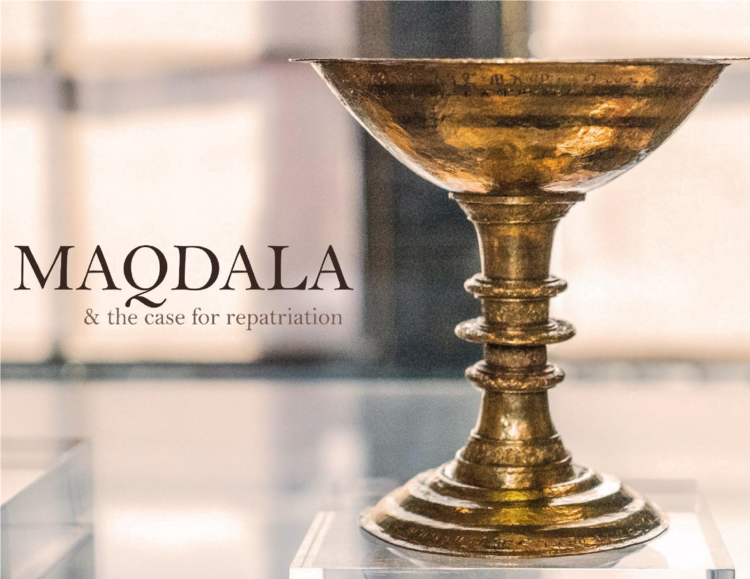
The year 2018 marks the 150th anniversary of the looting of the Maqdala treasures and manuscripts by British Soldiers from the town of Magdala, Ethiopia. So vast was the quantity of this loot that explorer H.M Stanley wrote, “Over a space growing more and more extended, the thousand articles were scattered until they dotted the surface of the rocky citadel, the slopes of the hill and the entire road to camp, two miles off”.
After the expedition, most of the items were brought to the UK where many of them were distributed among museums and institutions in the region such as the British museum, the Victoria and Albert (V & A) museum, the Oxford Bodleian library and others.

Figure 1: Maqdala 1868 display, V&A museum
Among the most valuable items from this loot are those acquired by the Victoria and Albert museum in 1872. These items, which include a stunning three-tier crown and a golden chalice are considered to be some of Ethiopia’s greatest historical/cultural treasures, yet they have been held in the UK for more than a century. In April 2018, when asked about the possibility of returning these treasures back to their rightful home, the V&A’s Director, indicated that the museum would be glad to assist Ethiopia in pursuing their return on a long-term loan basis … Now, one might be hard pressed to miss the sheer irony of this proposition.
How can looted artifacts be loaned back to the countries they were stolen from? Who exactly benefits from a power structure that continually states that a certain group of people need to prove that they are worthy of their own culture?
To find answers to these questions, we must examine the case of stolen cultural treasures from a wider lens and more so, that of African artifacts which are so often simply lumped into a ‘troubled history’ category.
An issue such as Maqdala is not unique to Ethiopia. From Congo, to Benin, to Namibia and Nigeria, several African countries have and continue to wrestle with the bureaucracies of trying to bring back cultural and archaeological objects taken during colonial times.
In the case of Nigeria, the loot from the 1897 sack of Benin City is today displayed in 85 museums around 18 countries. It is estimated that approximately 4000 items were looted from the city of Benin with most of them eventually ending up in Britain, France, Germany and the United States. Part of this loot included 160 bronze heads taken from the kingdom. These heads are said to have acted as the ‘Benin equivalent to chronological records’ with each of them representing a former King/Oba. Essentially tracing the history of the kingdom back several centuries, yet as I sit down to write about them a still voice in my head reminds me that Africa has no great history…I silence it, it is not my voice and this article must continue….
“Benin brass work was totally unknown in the West as it had been confined almost entirely to the royal palace and it so confounded current ideas about Africa that some refused to believe that it could be of exclusively Benin origin” — British Museum
While the looting of cultural objects during conflicts and wars has occurred in the world over, the case of African treasures is peculiar, not just in the scale of what was taken away but in what was intentionally left behind.
Where treasures once stood in homes, shrines and palaces, narratives of emptiness and nothingness were planted. Narratives that stated that African history started with colonialism and slavery, before that there was nothing.
A recent report by Bénédicte Savoy and Felwine Sarr estimated that close to 90–95% of Africa’s cultural heritage is held outside the continent.The complexities and wounds created by colonialism, slavery and years of systemic plunder cannot afford us the luxury of looking at these items as just objects. No…In their cracks and their crevices, they represent pride, loss, pain, identity and belonging. At the very least, they belong to the countries from which they were taken and at best, they belong to each and every individual who has been denied the fundamental right to appreciate and access tangible links to his or her own identity.
Nigerian poet and writer, Ben Okri once said “to poison a people…poison their stories”, and by denying Africans the right to own what is inherently part of their culture, Western museums still contribute to this system of cultural exploitation and disenfranchisement.
One might ask, on what grounds has this been allowed to continue for so long? In looking at previous repatriation requests, we see a painful trend where the same excuses are often floated to discredit and deny repatriation demands. More often than not, the reasons given will be centered around claims that Western museums are better placed to take care of these artifacts because they are ‘more secure’ and the expertise is better.
Indeed, it is no secret that cultural institutions around the world are equipped and funded differently. Neither do we refute that any advancements made through research and scholarship of cultural artifacts is of great benefit to the entire world.But is the complexity of training professionals, improving facilities in other museums and forging inter-institutional partnerships, so difficult and so complex that it can never ever be overcome? That it justifies separating sacred, cultural and national relics from their contexts? That 150 years later, we are still subjected to the same excuses?
The suggestion that millions of people have to prove that they are worthy of their own identity ultimately distracts us from the bigger picture, that these objects are being held against the will of the societies that own them, for the financial and social gain of societies that falsely claim them.
This idea that Africa is so dangerous that at any sign of trouble, we will flee and leave all our important artifacts behind because they mean nothing to us is completely condescending. So is the notion that Western museums have protected these artifacts from hypothetical harm, and we should be grateful to them instead of demanding for repatriation. It is no secret that most museums acquired objects from pre-colonial Africa at the height of slavery, colonialism and state perpetrated racial discrimination. Even when these objects are known to have been taken under such inhuman conditions, demands for restitution are still treated as trivial, baseless and meaningless. Why?
In Belgium for instance we know that human zoos displaying Congolese people in makeshift villages were once a common feature of trade fairs and exhibitions, with the last one being as recent as 1958. The earliest zoos were so popular that an entire museum was set up in Tervuren (Royal Museum for Central Africa), in 1898, to display “ King Leopold II’s Congo Free State”. During and after talks for independence, the Congolese government made several claims on the country’s cultural artifacts, specifically items within the Tervuren museum’s collection. The requests were largely rejected and as, scholar, Sarah Van Beurden’s research highlights, the Belgian government made deliberate attempts to keep the issue of repatriation of cultural artifacts out of any independence talks.
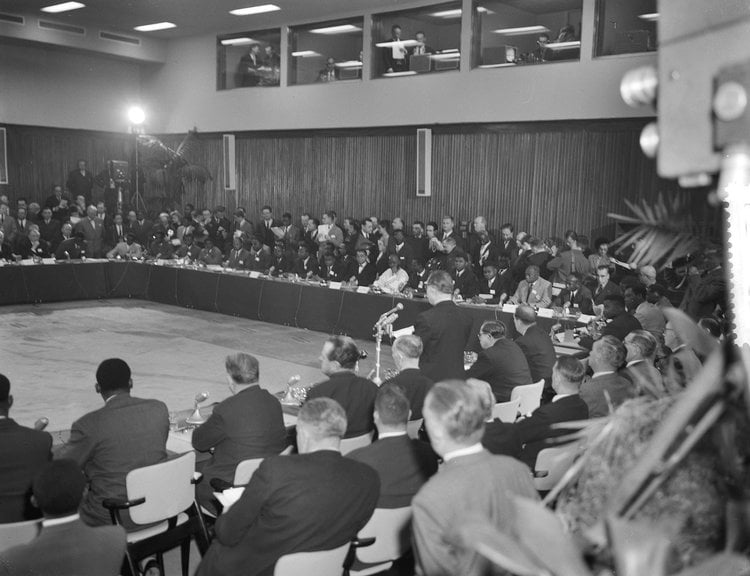
Belgian — Congolese Round Table Conference January 1960 — C/O Nationaal Archief
What it is important to understand is that demands for repatriation arise neither as a need for admiration nor endorsement. The aim is not to be given a stamp of approval for African culture or genius.
The issue here is the return of items that were painfully ripped apart from the living cultures and societies that they once belonged. And we have to ask ourselves again and again, who exactly benefits from the present power structure?
The integral issue that we must confront and speak up about today is this widespread cultural colonialism that constantly benefits a certain class of institution by virtue of disenfranchising the cultural wealth of other societies.
This notion that African countries are completely incapable of taking care of their own artifacts is a false narrative meant to alienate and it can be proved wrong. For instance, Kenya hosts some of the world’s largest and most important fossil collections, key among them, the Turkana boy, a nearly complete skeleton of a Homo Erectus youth found in 1984. To date it remains the world’s most complete early man skeleton.
A collection such as is this is unique in the world, and its benefits to research and scholarship are innumerable. Yet the ability of Kenya to take care of these fossils (on behalf of the world) has never been questioned. They are today held in a state of the art gallery on early man at the National Museum in Kenya where they have been since they were excavated.
Can we safely say that the only reason these objects are in Kenya is because they were found post-independence? If unearthed during the colonial era, would they have been shipped off to the British Museum and Kenya ‘unable to take care of them’?
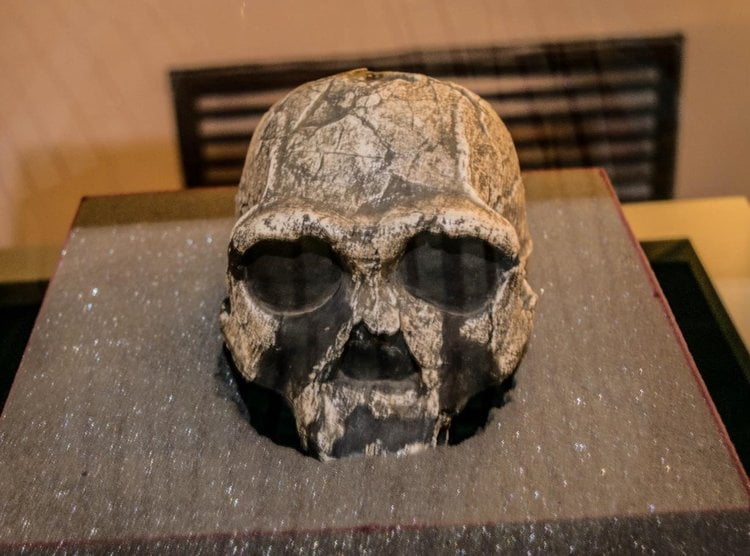
Figure 2: Homo Erectus skull on display in the Early Man gallery, National Museum of Kenya
To prove this further, is the case of the Timbuktu manuscripts.When Al Qaeda militants seized the legendary city of Timbuktu in 2012, they declared war on the city’s rich culture and threatened to destroy some of the city’s most priceless possessions; its manuscripts, which dated back to the 13th century .
Timbuktu’s manuscripts are not only important to Mali, they are important to the whole of Africa. When foreign scholars argued that the continent had no tradition of writing, therefore no history or memory of its own, the manuscripts served as a clear and tangible disavowal of this.
Such was the importance of these fragile, irreplaceable treasures that one librarian, Abdel Kader Haidara and his team, facilitated the daring rescue of more than 300,000 manuscripts from 45 different libraries around the city. Over a grueling nine-month period, Haidara and his team smuggled hundreds of thousands of manuscripts out of the city, relying heavily on the assistance of local families to hide and protect the texts, at a great risk to their lives and safety. The successful evacuation was a combination of both local and international efforts with organisations such as the Prince Claus Fund and the Ford Foundation supporting the evacuation efforts through financial aid.
What this shows is that even in times of turmoil, the people to whom culture means the most are willing to protect it, even at a great risk to their personal well being.
If the international community truly values artifacts such as the Benin bronzes or the Maqdala treasures as they did in the case of the Timbuktu manuscripts, then support should be geared towards ensuring they are preserved in the best way possible in their home countries. Efforts should be made to ensure that local communities are trained and are the first beneficiaries, culturally, socially and economically of their cultural heritage.
In the British museum, the Benin Bronzes will always be the Looted Benin Bronzes. In the V&A, the Maqdala jewels will always the Looted Maqdala Jewels…
At a time when Europe is closing its doors to immigrants and right-wing populism sweeps through the West, to argue that these objects should remain in Western museums because they are more accessible to the world is puzzling in the least. Again, we ask who is this global audience that has ease of access to these museums and the artifacts therein, when majority of Africans cannot be granted visas to Western countries? When dying at sea is not cause enough to be granted entry, will the simple leisure of viewing your historical artifacts get you through?
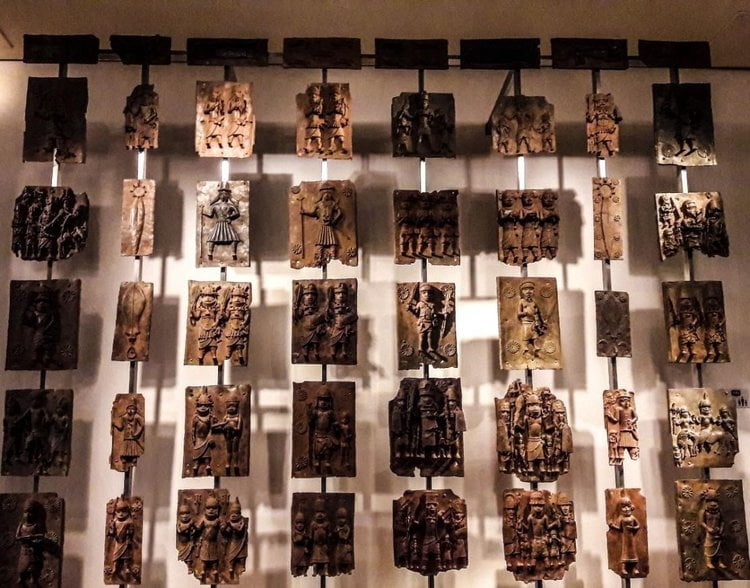
Figure 3: A section of the Benin Bronze statues displayed at the British Museum
It is not enough to say that objects will be loaned and simply expect people to accept and move on. We need to consider the place of Africa’s cultural industry in the development of the globalizing world. It is disingenuous to expect Africans to fund their museums when their most treasured artifacts and symbols of national pride are held in Berlin, Paris, New York or London.
A tourist in Ethiopia should be able to view the Maqdala jewels in the context of the artifact’s country of origin. The National Museum of Ethiopia should benefit financially from its objects being displayed in Addis Ababa or more so in the V&A. So would Museums in Nigeria if the Benin statues and carvings were displayed in the West African nation or loaned to museums in the West.
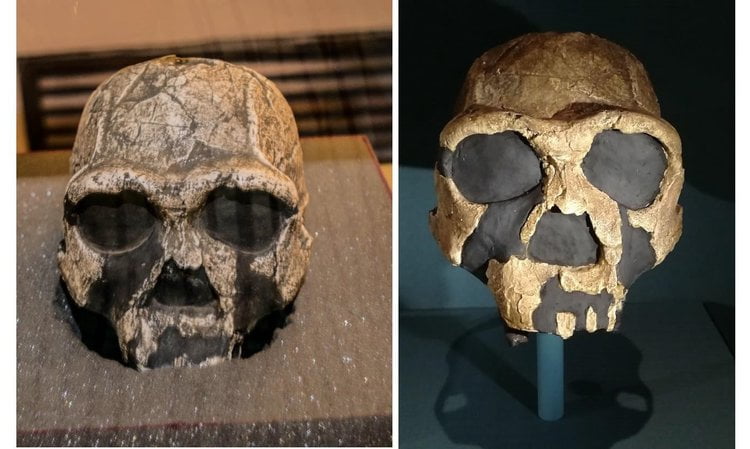
Figure 4: Left, Homo erectus skull found in National Museum, Kenya. Right, a model of the same skull in the Natural History Museum London.
Asking for cultural objects to be returned is not asking for them to be hidden from the world.
The case of the Kenyan fossils presents a model of shared heritage management that gives priority to the country of origin in exhibiting artifacts. The image above shows a skull from a Homo Erectus fossil at the National Museum of Kenya while the adjacent image shows a cast model of the same skull at the National History Museum in London. Repatriation should therefore not be used as a barrier towards global cultural consumption but as a pathway towards it.
“The gap created by this senseless exploitation is causing our people untold anguish, discomfort and disillusionment”. National Commission for Museums in Nigeria — Director Mallam Yusuf Abdallah
In examining the issue of repatriation, we see that up until this point very little has changed in a very long time. Yet one can’t help but acknowledge that at least one thing has changed; access to information. The silver lining of an issue such as Maqdala today is that it comes to light in an ever-changing era of technology and social media. Therefore opening up discussions on a subject that was previously limited to museum professionals, academics, professors, diplomats or politicians.
This is a subject that we should approach as humans who consume culture, create it, inherit it and pass it on. If this culture is to be consumed by the public, then that very well makes it a public discussion. Listen to us. Listen to our voices.
On 28th November 2017, in front of a room packed with University students in Burkina Faso, French president Emmanuel Macron made a historic statement regarding the return of Africa’s cultural artifacts. In it, he highlighted the glaring irony of the repatriation debate, a paradox that several before him and many today refuse to confront and choose to cloak in excuses and pretexts. This was the first time a leader of a former colonial power had acknowledged the immense loss that the possession of African artifacts in Western museums has had on African people. But this is something that several scholars, museum professionals and citizens have been saying for decades.
“I cannot accept that a large part of cultural heritage from several African countries is in France. There are historical explanations for that, but there are no valid justifications that are durable and unconditional. African heritage can’t just be in European private collections and museums. African heritage must be highlighted in Paris, but also in Dakar, in Lagos, in Cotonou.”- Emmanuel Macron
Macron pledged to make the return of objects a priority within the next five years, and it comes as a breath of fresh air for many who have been calling for change and restitution. Most recently the recommendations, made in this significant report on African artifacts held within France, could have far reaching impact on the international museum scene. The world is changing, and museums have the responsibility of representing the past to a generation, whose ideals may be entirely different from the past they consume.
Millions of African children still grow up, being embarrassed of their own ‘limited’ history, when they look to their museums and they cannot find symbols of their glorious past. Yet these artifacts line the halls of foreign museums.
I know because I was one of those children.
I had to actively seek out my own true history as a young adult to discover a pride that I never knew I had inside. For this reason, we refuse to remain silent. History is a conduit to national and individual pride. Institutions such as museums and archives stand at the gateways to this path.
As I conclude this article the voice in my head that once said I come from nothing fades away, it is replaced by a peaceful stillness, I wait…and I can finally hear the beating of my own heart. The other half of my story lies within. Listen…Demands for restitution will not end or be brushed aside easily. Each new generation will continue to demand for the return of its artifacts and with each object and each request, a different truth will emerge. Or perhaps best put in the words of the great Patrice Lumumba himself…
“History will one day have its say; it will not be the history taught in…Washington, Paris, or Brussels…Africa will write its own history, and it will be…a history of glory and dignity.”
All images courtesy of www.africandigitalheritage.com unless otherwise stated.